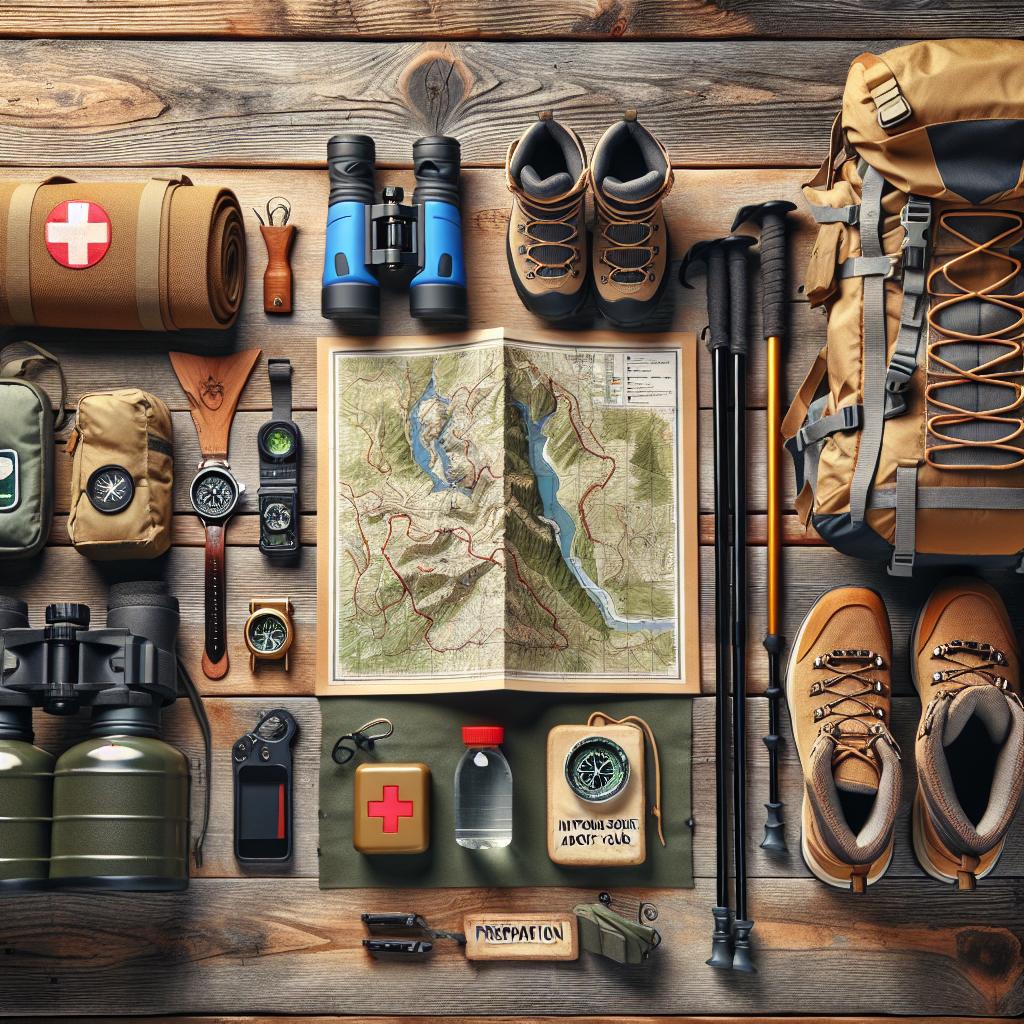Imagine stepping into a world where the trees whisper secrets of centuries past, and the air, crisp and lightly scented with pine, carries a refreshing sense of solitude. This is the embrace of the Smoky Mountains, a sprawling sanctuary that stretches across the borders of Tennessee and North Carolina. Here, amidst the shadows and light, lie remote and secluded hiking trails waiting to be discovered. Navigating these hidden paths is an invitation to leave behind the clamor of everyday life and reconnect with the serene, wild heart of nature. Whether you’re a seasoned hiker seeking the thrill of the unbeaten path, or an adventurous soul eager to uncover the mysteries that dense forests and lofty ridges conceal, this article is your guide to exploring the untamed beauty of the Smokies. Prepare to embark on a journey where every step reveals a new vista, and every trail tells its own story.
Discover Hidden Gems: Planning Your Smoky Mountains Adventure
Embarking on a journey through the remote and secluded hiking trails of the Smoky Mountains offers an adventure like no other. These lesser-known paths provide a serene escape from the more frequented routes, unveiling the raw beauty of nature in its most unspoiled form. Consider exploring trails such as Porters Creek Trail that lead you through lush forests, by cascading waterfalls, and past historical ruins. Or perhaps the Boogerman Trail, renowned for its towering, ancient trees and tranquil ambiance. Ensure you bring the essentials to make your hike safe and enjoyable:
- Navigation Tools: A detailed map and compass
- Proper Footwear: Sturdy hiking boots
- Safety Gear: First aid kit and whistle
- Provisions: Adequate food and water supplies
- Weather Protection: Rain gear and layered clothing
For the avid adventurer looking to dive deeper into the heart of the Smokies, reviewing trail difficulty and features ahead can make a world of difference. Here’s a handy table to help you choose the perfect hidden gem for your capabilities:
| Trail Name | Difficulty | Highlights |
|---|---|---|
| Porters Creek Trail | Moderate | Waterfalls, Historic Sites |
| Boogerman Trail | Strenuous | Ancient Trees, Seclusion |
| Alum Cave Trail | Moderate | Arch Rock, Cave Bluffs |
| Grape Yard Ridge | Easy | Quiet Forest, Scenic Views |

Essential Gear and Preparation Tips for Remote Hiking
When embarking on a remote hike in the Smoky Mountains, the right gear can be the difference between a memorable adventure and a hazardous misadventure. First and foremost, invest in a high-quality backpack with ergonomic support and ample storage. Your pack should include waterproof layers to keep your gear dry and multiple compartments for organization. Pack the essentials: a first-aid kit, hydration system (preferably with a built-in filtration device), and navigation tools such as a map, compass, and GPS device. Footwear can make or break your hike; opt for durable, water-resistant hiking boots with strong ankle support. Don’t forget to bring hiking poles, which provide stability and reduce strain on your joints during uneven terrain.
Equally vital is comprehensive preparation to ensure you’re ready for any situation. Familiarize yourself with the trail by studying topographical maps and reading recent trail reports. Dress in layers—weather conditions can fluctuate rapidly in remote areas. Moisture-wicking base layers, insulating mid-layers, and weather-resistant outerwear are essential. Ensure you have enough food and water for the duration of your hike, plus extra in case of delays. Create a checklist that includes items such as emergency shelter, multi-tool, fire starter, and a flashlight with extra batteries. inform someone of your itinerary and expected return time; having a communication plan can be lifesaving.
- High-quality backpack
- Waterproof layers
- Navigation tools
- First-aid kit
- Hydration system
- Durable hiking boots
- Hiking poles
| Item | Purpose |
|---|---|
| Map & Compass | Navigation |
| First-Aid Kit | Medical Emergencies |
| Fire Starter | Emergency Warmth |

Navigating Nature: Reading Trails and Terrain Accurately
Hiking in the Smoky Mountains presents adventurers with a range of trails, each offering its own set of challenges and rewards. Whether you’re trekking through dense forestry or over rocky ridges, sharpening your skills in reading nature’s signs is essential. Start by observing trail markers; these can range from painted blazes on trees to stone cairns along rocky paths. Animal tracks and scat can also be telltale signs of whether you’re straying into wildlife territory. For an extra layer of safety, always make it a point to carry a topographic map and a compass. While GPS devices are incredibly handy, they can fail in areas with poor signal, so mastering traditional navigation skills is invaluable.
As you move deeper into the remote trails of the Smoky Mountains, terrain reading becomes increasingly critical. Look out for soil color and texture changes; these can signify natural borders or transition areas. Moss growth on the northern side of trees can act as a natural compass. When navigating across ridges or through ravines, pay attention to water sources and drainage patterns, as these are often the key to understanding the larger landscape. Plant clusters and forest composition can also give insights into the terrain type you’re traversing. The combination of these cues will help you move more confidently and ensure a safer, more enjoyable hiking experience.
| Trail Feature | Navigation Tip |
|---|---|
| Trail Markers | Follow painted blazes or stone cairns |
| Animal Tracks | Identify to avoid wildlife areas |
| Moss Growth | Use as a natural compass |
| Water Sources | Understand drainage patterns |
| Soil Changes | Spot natural borders |

Safety First: Strategies for Surviving Unexpected Challenges
When exploring remote and secluded hiking trails in the Smoky Mountains, maintaining awareness and preparing for the unexpected are crucial. These trails are often far from the regular paths, meaning you might not encounter other hikers frequently. It’s important to pack essentials such as ample water and snacks, a first aid kit, and a map or a GPS device. Though the Smokies’ wilderness is awe-inspiring, it can also be unpredictable. Before heading out, check the weather forecast and let someone know your intended route and return time. In case of severe conditions, be ready to alter plans and seek shelter if necessary. Stay vigilant and avoid wandering into unmarked areas, as these could lead to hazardous situations.
To further ensure your safety, consider these key strategies:
- Buddy System: Hike with a partner whenever possible to increase safety and share responsibilities.
- Stay on Marked Trails: Ensure that you’re following clearly marked trails to avoid getting lost.
- Wildlife Awareness: The Smoky Mountains are home to diverse wildlife. Keep a safe distance and do not feed any animals.
- Layered Clothing: Weather can be unpredictable, so dress in layers to quickly adjust to changing conditions.
- Emergency Signals: Carry a whistle or a mirror to signal for help if needed.
Here’s a quick checklist to keep handy:
| Essential Items | Importance |
|---|---|
| Water and Snacks | High |
| First Aid Kit | High |
| Map/GPS Device | Medium |
| Weather-appropriate Clothing | High |
| Emergency Whistle | Medium |
Q&A
Title: Navigating Remote and Secluded Hiking Trails in the Smoky Mountains
Q: What makes the Smoky Mountains a unique destination for hikers?
A: The Smoky Mountains offer a diversity of ecosystems, captivating wildlife, and breathtaking panoramic views. With both well-trodden paths and hidden trails, hikers can experience both serenely secluded spots and popular scenic routes all within this ancient mountain range.
Q: How should one prepare for hiking on remote trails in the Smoky Mountains?
A: Preparation is key. Start by researching your chosen trail – maps and guidebooks are invaluable. Ensure you pack essential supplies: plenty of water, high-energy snacks, a first-aid kit, a reliable navigation tool (be it a GPS or a map and compass), and appropriate clothing for sudden weather changes. Inform someone about your plans and expected return time.
Q: What are some remote trails in the Smoky Mountains that offer a sense of solitude?
A: The Benton MacKaye Trail and sections of the Deep Creek Trail are exemplary choices for solitude seekers. These trails weave through dense forests and alongside pristine streams, providing a retreat from the busier trailheads and more frequented paths.
Q: Are there any specific safety concerns when hiking remote trails in this area?
A: Yes, safety concerns include rapidly changing weather, wildlife encounters, and the risk of getting lost. It’s crucial to be aware of your surroundings and stay on marked trails. Encounters with black bears are rare but possible, so knowing bear safety practices can be lifesaving. Also, cell phone reception is inconsistent; hence, a tangible map is a necessity.
Q: How can a hiker respect and protect the natural environment of the Smoky Mountains?
A: Following Leave No Trace principles is the heart of preserving the wilderness. This means carrying out all trash, minimizing campfire impacts, respecting wildlife by maintaining a safe distance, and staying on established trails to prevent erosion and protect native flora.
Q: Are there resources or local groups that can help newcomers to hiking in the Smoky Mountains?
A: Absolutely. The Great Smoky Mountains National Park’s visitor centers provide ample resources, including maps, trail conditions, and ranger-led programs. Local hiking clubs and online forums also offer support and community, often organizing group hikes that can be both informative and reassuring for newcomers.
Q: What should a hiker do in case of an emergency on a remote trail?
A: Staying calm is the first step. If you’re lost, avoid venturing further away from your known location. Use a whistle or other signaling device to attract attention. If you have cell signal, call emergency services providing detailed information about your location and condition. Ensure you have an emergency plan in place before setting out, and if traveling solo, it’s wise to carry a personal locator beacon (PLB) or satellite communicator.
Q: What kind of wildlife can hikers expect to encounter, and how should they handle these encounters?
A: The Smoky Mountains are home to black bears, white-tailed deer, elk, and various bird species. Encounters with wildlife should be handled with respect and caution. Observing animals from a distance, securely storing food, and making noise to avoid surprising animals can prevent most negative encounters, keeping both hikers and wildlife safe.
Q: What is one unforgettable experience a hiker can expect while navigating these secluded trails?
A: One unforgettable experience is witnessing the early morning mist lifting off the forested valleys, revealing the majestic landscape that gives the Smoky Mountains their name. The stillness and serene beauty of such moments are often unmatched, providing a profound connection to nature that many hikers cherish deeply.
By approaching the Smoky Mountains with respect, preparation, and a sense of adventure, hikers can safely explore the remote and secluded trails, creating memories that will last a lifetime.
In Retrospect
As you lace up your boots and tighten the straps of your backpack, it’s worth remembering that the Smoky Mountains hold secrets that reveal themselves only to those who wander its hidden paths. Whether you find yourself crossing the whispering streams in deep hollows or catching a glimpse of wildlife in the untouched stretches of wilderness, each step leads you further into an enchanting realm where nature speaks in hushed tones and ancient rhythms.
Navigating these remote and secluded trails isn’t just a journey on foot—it’s a pilgrimage of sorts, guiding you back to a simpler connection with the world around you. The Smoky Mountains, with their mist-clad peaks and shadowed forests, offer a canvas that invites both reflection and adventure. So as you set forth on these hidden trails, remember to tread lightly, savor each moment, and let the mountains unfold their quiet magic at every turn.
Here’s to the trails less traveled and the stories yet to be discovered, tucked away in the Smokies’ serene embrace. Happy hiking.

